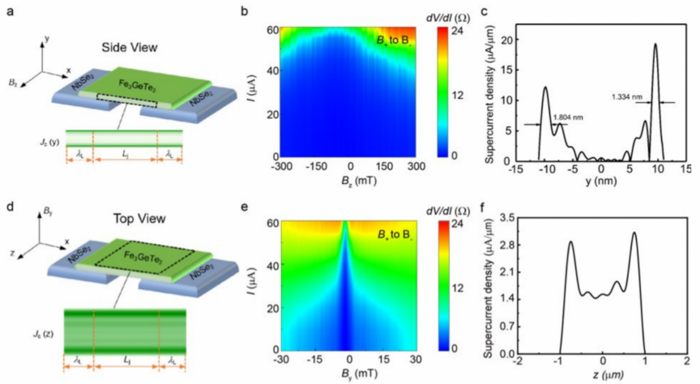In a recent study published in Nature Communications, researchers discovered the long-range skin Josephson supercurrent across a van der Waals ferromagnet. The study was achieved by a research group led by Prof. XIANG Bin from Hefei National Laboratory for Physical Sciences at the Microscale, in collaboration with Associate Prof. WANG Zhi from Sun Yat-sen University (SYSU). They bridged two spin-singlet superconductors NbSe2 (S) by constructing the van der Waals ferromagnet metal Fe3GeTe2 (F), and observed long-range supercurrent in the lateral Josephson junction (S/F/S) for the first time. The long-range supercurrent exhibits astonishing skin characteristics.

Credit: Image by HU Guojing et al.
In a recent study published in Nature Communications, researchers discovered the long-range skin Josephson supercurrent across a van der Waals ferromagnet. The study was achieved by a research group led by Prof. XIANG Bin from Hefei National Laboratory for Physical Sciences at the Microscale, in collaboration with Associate Prof. WANG Zhi from Sun Yat-sen University (SYSU). They bridged two spin-singlet superconductors NbSe2 (S) by constructing the van der Waals ferromagnet metal Fe3GeTe2 (F), and observed long-range supercurrent in the lateral Josephson junction (S/F/S) for the first time. The long-range supercurrent exhibits astonishing skin characteristics.
Ferromagnetism and superconductivity are two antagonistic macroscopic orderings. When the singlet supercurrent enters the ferromagnet, rapid decoherence of the Cooper pairs will be triggered. However, spin-triplet supercurrents induced in the vicinity of superconductor/ferromagnet interfaces enable transport without energy dissipation over long distances in ferromagnets, which has been proved theoretically and experimentally in recent years. Therefore, it provides a more desirable method for constructing quantum devices without dissipation. Earlier research focused on the construction of superconducting Josephson junctions with coupled bulk ferromagnets, to achieve the observation of spin-triplet currents and the control of spin and charge degrees of freedom. However, there are few reports on the observation of spin-triplet supercurrents and related studies of interfacial properties based on heterojunctions of two-dimensional (2D) van der Waals (vdW) materials.
The research team constructed lateral vdW Josephson junctions of S/F/S by bridging two singlet vdW superconductors NbSe2 with vdW ferromagnet Fe3GeTe2 (F). The electrical properties of the S/F/S with different junction channel lengths have been studied by low-temperature electrical tests. The results showed a zero-resistance state of the S/F/S and also a long-range Josephson supercurrent (~ 300 nm). The zero-temperature superconducting critical current tends to decay with increasing channel length and disappears completely when the channel length increases to 450 nm.
More interestingly, the response of the long-range superconducting critical current to an external magnetic field perpendicular to the supercurrent channel presents a periodic oscillation pattern, which is similar to double-slit interference, rather than the conventional Fraunhofer periodic oscillation stripe. This result confirms the existence of a Josephson supercurrent with a long-range skin feature in S/F/S, that is distinctive from the Josephson superconducting current of conventional bulk channels.
Then the research team proposed two possible mechanisms for the skin feature of the long-range supercurrent. First, the Rashba spin-orbit coupling induced by the mirror symmetry breaking on the Fe3GeTe2 surface, when interacting with ferromagnetism and the s-wave superconductivity of NbSe2, may lead to 2D topological superconductivity on the Fe3GeTe2 surface. Second, the magnetic inhomogeneity caused by the non-coplanar structure of Fe atoms in Fe3GeTe2 promotes the transformation of spin-singlet Cooper pairs into spin-triplet pairs at the surface through spin-rotation and spin-mixing, and then forms a long-range Josephson supercurrent.
The S/F/S design of the noncoplanar structure provides a new perspective to explore the interaction between ferromagnetism and superconductivity. The novel physical properties presented by this noncoplanar structure provide a platform for potential applications of new quantum functional devices in 2D superconducting spintronics and the realization of topological superconductivity.
DOI
10.1038/s41467-023-37603-9
Article Title
Long-range skin Josephson supercurrent across a van der Waals ferromagnet




